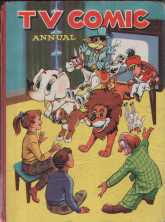
This TV Comic Annual shows on its cover, amongst others, Muffin the Mule, Billy Bean, Pakki the Elephant, Lenny the Lion, Bengo the Boxer Pup, Coco the Clown and Bom the little Drummer Boy. (Click on the picture to enlarge)
Home > Children's Programmes > Other Children's TV
Below is a selection of other Children's TV programmes of the 1950's. If you have any information about these or any other programmes of the era, we would be very grateful to receive it. Just e-mail the address at the foot of this page and we will try to feature them on their own pages:

This TV Comic Annual shows on its cover, amongst others, Muffin
the Mule, Billy Bean, Pakki the Elephant, Lenny the Lion, Bengo
the Boxer Pup, Coco the Clown and Bom the little Drummer Boy.
(Click on the picture to enlarge)
| 'The Hot Chestnut Man' stories told by Johnny Morris Johnny Morris' catchphrase was used
near the beginning of the programme, when he gave his
young viewers a brief outline of the week's story and
asked whether he'd told it before: |
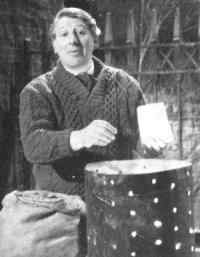 |
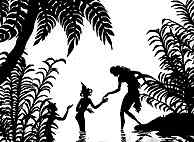 |
Lotte Reiniger's Shadow Puppets Her silhouette films were featured on both BBC and independent television. She had begun making them in 1920, and in 1926 produced Prince Achmed, the first full-length silhouette film. It took her three years to make and is regarded by many as a classic. Production of her films involved hundreds of sketches and cut-outs, each wired so that the limbs and head could be easily moved. The cut-out figures were placed between glass and transparent paper and were photographed by Lotte's husband Carl Kock. A twelve minute film produced this way required about 15,000 shots. Link to more information on Lotte Reiniger Buy Lotte Reiniger prints from BFI |
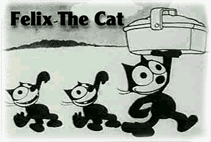
Visit LikeTelevision for a Felix cartoon adventure |
'Felix the Cat' In February 1956 ITV began to use some old Felix cartoons in a short series. The cat had been created by Otto Mesmer and developed by Pat Sullivan after Paramount had been interested enough in the original artwork to sign him up for the Paramount Screen Magazine. The first moving cartoon was made in 1919 and was called Feline Follies. In the second, called Musical Mews, Felix was officially named. With Sullivan's promotion, the cat's popularity grew even greater in Britain than in the USA. He was not, however, able to survive the transition to sound; in fact many of the visual gags were essentially due to the absence of a soundtrack - the antics of speechbubbles, the animation of punctuation marks. He had a few revivals, one in 1935 with a new series of cartoons being produced, and television showings in the 50's and '60s. The comic strip continued for many years into the fifties but Felix eventually stopped walking.
Visit Felixthecat.com |
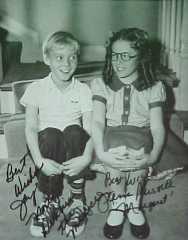 Jay North and Jeanne Russell as Dennis and Margaret |
'Dennis the Menace' (1959-1963) starred Jay North as Dennis and Joseph Kearns as "Good ol' Mr. Wilson" |
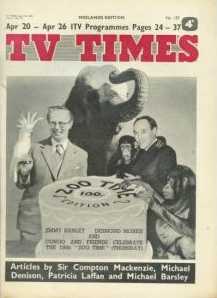 |
'Zoo Time' (1956) With Desmond Morris. The programme was transmitted from a studio inside London Zoo. Desmond was not the only star of Zoo Time, Congo, the chimp always appeared in the early shows. |
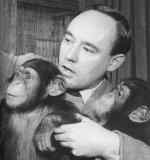 |

Visit LikeTelevision for a Full Popeye cartoon adventure |
 Was first presented on ITV in February 1958. The on-off love affair of Popeye and Olive Oyl, aggravated by the usually villainous Bluto, the innocuous hamburger-munching J. Wellington Wimpy ('I'd gladly pay you Tuesday'), and the amusingly irritating Swee' Pea, were the regular attractions of this long-running cartoon series. Some of his adventures, especially the two-reelers of Popeye Meets Ali Baba and the Forty Thieves, Sinbad, and Popeye Meets Aladdin and his Wonderful Lamp, are classics, having such memorable asides as 'Abul Hassan got 'em any more', 'Open sez-me' and 'Salame ,salame, baloney'. It was the 'goons' who appeared in the cartoon Goons of Goon Island that inspired Spike Milligan to name his famous radio shows. More Halas and Batchelor cartoons |
'The Cabin in the Clearing' (1954) Besieged in their log cabin by Shawnee Indians, Silas Sutherland, his wife Polly, and his daughter Alice, are cut off from all help. Their negro servant Scipio is captured, whilst out looking for an escaped cow, by the Indians who had already found and eaten the cow, and held prisoner in the forest outside, though lurking nearby are Mul-keep-mo, a friendly Miami Indian and young Brayton Ripley, a white scout. Scipio escapes by clubbing his guard with the cow's skull and then joins Brayton Ripley. But the Indians have kindled a fire under the wall of the cabin . . . There was a love interest between Brayton and Alice Sutherland. Brayton was "blood brother" to Mul-keep-mo, each saving the other's life. There were tomahawk fights between the Indians. The Sutherland women attempted to escape by waggon but were themselves captured, but saved by the men. A television play in 5 episodes. Adapted by Felix Felton and Susan Ashman from the novel by E.S. Ellis. Produced by Rex Tucker and directed by Patrick Dowling. Cast: Silas Sutherland - Shaun Sutton; Polly his wife - Peggy Mount; Alice, his daughter - Ann Hanslip; Scipio - Charles Swain; Brayton Ripley - Derek Aylward; Mul-keep-mo - Ewen Solon; Haw-bu-da - Carl Duering; The Owl - Shaw Taylor; Shawnee Indians - Saul David, John Hoskin. Settings by Richard Henry. The incidental music was Dvorak's New World Symphony 1—'Friends
and Foes' 2—'Besieged'
3—'Ordeal
by Fire' 4—'A Desperate Plan' 5—'The Break-Out' The BBC screened another production of the play in 1958. A viewer's memories: Despite its subject matter, it was clearly studio-based. The settlers lived in a log cabin and came under frequent attack from Indians whom they usually shot with flintlock rifles as they ran at the cabin, tomahawks in hand. Sometimes they tried to burn the cabin but were usually thwarted. Once or twice they evaded the gunfire and got right up to the cabin, crouching under the small windows with a view to climbing inside at the earliest opportunity. |
'The Black Tulip' (1956) The Black Tulip by Alexandre Dumas was serialised for children by the BBC in five episodes during August and September 1956. The serial starred Douglas Wilmer as Cornelius van Baerle, Sheila Shand Gibbs as Rosa, Anthony Jacobs as Isaac Boxtel, Henry Davies as Prince William of Orange, Michael Aldridge as Mynheer van Spennen, Mervyn Blake as Gryphus and also featured Peter Diamond as the Guard The serial was directed and produced by Naomi Capon. The episodes were as follows: The
Traitors: 21 August 1956 Design was by Charles Lawrence |
'Emil and the Detectives' (1952) Serialised for children by BBC in 3 x 35 minute episodes Emil and the Detectives was a 1929 novel for children set in Germany by the German writer Erich Kastner. It was Kästner's first major success and the only one of his pre-1945 works to escape Nazi censorship. The most unusual aspect of the novel, compared to existing children's literature at the time, was that it was realistically set in a contemporary Berlin peopled with some fairly rough characters, not in a sanitized fantasy world; also that it refrained from all-too-obvious moralizing, letting the characters' deeds speak for themselves. The serial starred Robert Sandford as Emil Tichburn, Robert Marsden as The Man in the Bowler Hat, Barbara Trevor as Grandma, Carole Lorimer as Pony Hutchings, Glyn Dearman as The Professor, Donald Masters as Cashier, Derek Rowe as Little Tuesday, Robert Scroggins as Butters and Anthony Valentine as Trout. The episodes were: The
Man in the Bowler Hat: 8 April 1952 The title music was Vaughan Williams overture to The Wasps |
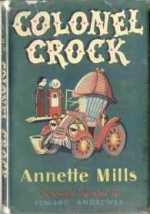 |
'Colonel Crock' - written by Annette Mills and presented by Edward Andrewes, who also drew the pictures, and featuring the adventures of Colonel Crock, a retired Army car with a deerstalker hat who lives in the car-village of Much Winding along with other vehicles like Lady Limousine (of Winding Hall), Violet the Van proprietor of the grocery shop, and Jake Jeep Jnr. who stayed on when the American forces left, and their human friend Bill Mags the Mechanic who ran the local garage. Other characters were Charlie the Coach, Monty the Motor, Samuel Seven and Daniel the Donkey. |  |
'Vegatable Village' The first glove puppet series for children on BBC Television was the everyday story of a village of vegetable characters: Bertie Bean, Barbara Beet, Granfer Marrow, Miss Mushroom, the village postmistress, Annie Apple, the school teacher, PC Swede, Dr Parsnip, Squire Strawberry and, the village baddie Tramp Toadstool. It was broadcast live from Lime Grove Studios in two weekly series starting in July 1951. The series was commissioned by Cecil Madden, devised by Rita Pope and Arthur H. Allen. Puppeteers were : H. G. Bigg, Joyce Hoggett and Ronald Bigg. Voices by Sibell Gill, Pamela May and Peter Madden. Producer: John Warrington. .
|
with
Nat Temple and his Band |
Archie finds himself in an antique shop owned by Theodore Hubble, who has two children, Ronnie and Rona. Written
by Godfrey Harrison from an idea by A. A. Dubens, it
starred June Allen as Rona, Barry McGregor as Ronnie and
Bruce Gordon as The Man In the Armour and was produced by
Rex Tucker. The theme tune used was 'Horse Feathers' by Philip Green. Other music used was: Comic Mystic by Robert Farnon and Three Bears Phantasy by Eric Coates. |
| 'The Gordon
Honour' - Chronicled the continuing (over
several generations) family feud between The Gordon
family and The Fitzwilliam family over the disputed
possession of a candlestick which had been presented to
one of them for a service rendered. Each generation was
played by the same actors - just a change of beards. Paul
Whitsun-Jones (a ubiquitous character actor of the time)
played The Duke of Tyburn, the head of the Gordons,
who had a somewhat
ineffectual nephew called Freddy, played by Bruce Gordon,
who fell in love with the only retainer, Poppy the maid. There were two series of the Gordon Honour and there were two simultaneous plots. In the present was the attempt by the two Fitzwilliams, just criminals, to steal the Gordon Honour, a candle stick to which a new arm was added after each act of heroism by the Gordon family. However, Freddy was a bit of wimp and could never do any act of heroism that would result in a further arm being attached. However, he finally did so and honour was satisfied. During the setting there would be a lull, while Paul Whitsun-Jones, would tell his nephew all about an exploit of one of the ancestors which would be shown as a separate action. The Fitzwilliams were not only trying to steal the candle stick but were, in every generation, showing treachery to the King. The first episode was a servant boy saving the life of King Arthur from the Fitzwilliam, a knight of the Round Table and being knighted Sir Varlet Gordon. There would be a love interest with a servant girl each time. In another episode, the Gordon of the time was with King Richard in the Holy Land. A memorable line was him saying to the King "Who will kill the Saracens while I am away?" (on a desperate mission) with the King replying "I'll do that". Another episode was set in the court of Queen Elizabeth the First and was based around an assassination attempt on the Queen. The main characters were an eccentric alchemist, Sir Walter Raleigh, Queen Elizabeth and, of course, the Gordon heroes and the villains. The Queen was presented with a unique delicacy by Sir Walter -- a potato which she tried to eat but which was raw. Someone shouted, "You fool. It is supposed to be cooked!" The alchemist immediately rushed to assist. He speared the potato on a fork placed it in a candle flame to cook and then said, "Funny. This burns with the colour of the poison I have in my laboratory." etc. etc. The final episode of the first series had the earlier Gordon based in Ireland in 1916 watching a suspected German agent. In the second series, the Fitzwilliams escaped from prison and again invaded the castle. By the end of the series, Freddy had changed from a feeble youth to physically knocking both the Fitzwilliams out to the delayed delight of his irascable uncle. The Fitzwilliam family seemed eternally doomed in their quest to recover the candlestick and were represented by actors Colin Douglas and Barry Letts. The signature tune was "The Yeomen of England" by Edward German. |
and...............
'Children's Newsreel' was a weekly precursor to 'John Craven's Newsround'. Launched in 1951 and edited by Don Smith who had worked on the Televison Newsreel Unit. Mary Malcolm and Stephen Grenfell became the first commentators for the weekly fifteen minute programme. The opening title sequence of 'transmission waves' radiating from the mast of Alexandra Palace is one of the indelible memories of the early Lime Grove programmes.

Children's Newsreel Theme
The theme tune is called
"Holiday Spirit" and was composed by Clive Richardson.
'Rex Milligan' - Anthony Buckeridge's invention, was decidedly part of the grammar school education system. Much of the action of this TV series being based on rivalry between the grammar school boys and those from the technical school.
Ross Salmon - A "real" cowboy informing us about what being a cowboy is all about, things like how to recognise different animal footprints, or how to whittle, the art of horse management, how to make and use a lasso ....etc.... Ross Salmon, originally appeared on Shirley Abicair's programmes before launching his own series. He was in fact English and had retired from the Navy. He set up an American Western style ranch called the "Lazy S" at Longdown in Devon and introduced a breed of hardy cattle. There were a series of Ross Salmon books and annuals, printed in the 50's.
In 1957, at the age of 34, he was thrown from his horse 'Faithful' and vowed to quit 'riding the range'. "Posing as a super-fit cowboy to children has been rather a fraud", he said after the accident. "I'm the victim of an old man's disease - osteo-arthritis - following a plane crash in the South American jungle, and have to wear a spinal jacket"
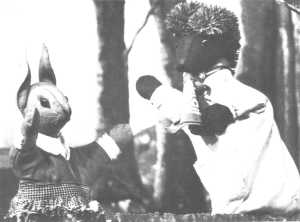 'Little Grey Rabbit' (Sept. 1950) arranged and told by
Ann Hogarth and Jan Bussell with their glove puppets.
'Little Grey Rabbit' (Sept. 1950) arranged and told by
Ann Hogarth and Jan Bussell with their glove puppets.
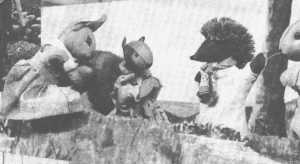
'The Black Brigand' (1956) - starred William Devlin as Carl the
White King, Laidman Browne as Don Rogano and
Anthony Newlands played Fernando. Carl
the White King was a Macchiavelian figure who ruled the country
with cruelty and oppression. Don Fernando, exiled from
court, was a Robin Hood/ Zorro type figure who redressed ordinary
people's grievances, but whose identity was unknown to the
King. There were several traps set for him which he escaped
in a thrilling manner. There was a love interest with
Esmeralda, a gipsy girl and on one occasion separated from his
followers, they were trapped in a cave on a cliff top by the
advancing members of the government forces. Deciding to finish
off the Black Brigand and his men once and for all, the White
King gives the order to set fire to the dry corn on the cliff
top. He knows that the only ‘escape route’ for the
Black Brigand and his men is a quick death by throwing themselves
off the cliff. The fire rages towards the Black Brigand and his
men …
The White King rubs his hands together knowing that this is the
end of the Black Brigand. With the fire raging towards them and
the cliff face, the Black Brigand’s men know they are
certain to die …
However, the Black Brigand has an idea up his sleeve. There is
one way to possibly save themselves and the Black Brgand gives
the order for his men to form a line. With the fire now raging at
their backs, the men light second fires in front of them. Now
there are two lines of fire raging towards the cliff with the
Black Brigand and his men situated in the division between the
two lines. However, when the first line of fire reaches the
already burnt out corn lighted by the Black Brigand. it’s
extinguished because something that’s already burnt will not
burn again!
The Black Brigand and his men are saved!
Esmeralda was found to have a better claim to the throne than
Carl. The climax was a banquet at which Carl attempted to
poison Fernando, whose identity was now known to him. He
was saved by the sudden death of a retainer who had taken a swig
from the poisoned chalice. There was an exciting sword duel
between the King and the Black Brigand in which Carl was
killed. Esmeralda was crowned Queen and married Fernando.
The signature tune of this swashbuckling adventure series
featured words which were something like : -
"Black
are their hats, Black Hats,
Black are
their cloaks, Black cloaks,
We keep the
army on the run, On the run
The Black Brigands
men will come,
The Black Brigands men will come,
Saddles of leather thunder together,
Swords..... gleaming in the sun."
This was accompanied by footage of the aforementioned brigands galloping across the screen.
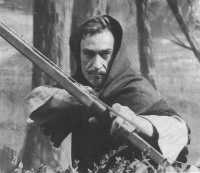 Robin Hood (1953) - was a 30-minute serial in six
parts written by Max Kester and based on the traditional medieval
story. Patrick Troughton (right) starred as Robin, with
Kenneth Mackintosh as Little John, Wensley Pithey as Friar Tuck,
and David Kossoff as the Sheriff of Nottingham. The serial was
produced by Joy Harington.
Robin Hood (1953) - was a 30-minute serial in six
parts written by Max Kester and based on the traditional medieval
story. Patrick Troughton (right) starred as Robin, with
Kenneth Mackintosh as Little John, Wensley Pithey as Friar Tuck,
and David Kossoff as the Sheriff of Nottingham. The serial was
produced by Joy Harington.
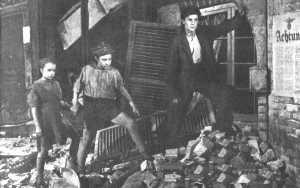 'The Silver Sword' - serialised in 1958, was about a
Polish family separated during the Second World War and trying to
find each other again when the war is over. The author of the
book, Ian Serraillier, spent five years on the research. Ruth was
defined by the calm, unselfish way she dealt with the setbacks
which befell them, her good humour in appalling circumstances,
and her sure sense of right and wrong. Jan was a thieving urchin
who loved animals and hated Germans. The Silver Sword was a sort
of mascot (actually a paper knife), turning up at various key
points and threading the story together.
'The Silver Sword' - serialised in 1958, was about a
Polish family separated during the Second World War and trying to
find each other again when the war is over. The author of the
book, Ian Serraillier, spent five years on the research. Ruth was
defined by the calm, unselfish way she dealt with the setbacks
which befell them, her good humour in appalling circumstances,
and her sure sense of right and wrong. Jan was a thieving urchin
who loved animals and hated Germans. The Silver Sword was a sort
of mascot (actually a paper knife), turning up at various key
points and threading the story together.
Gwen Watford played Margrit Balicki, Jan was played by Frazer
Hines, and Ruth's brother, Edek, by Melvyn Hayes (looking particularly consumptive and
malnourished). Other parts were Barry Letts as Joseph Baliki, Pat
Pleasence as Ruth and Ingrid Sylvester as Bronia.
'Pig-Hoo-o-o-o-ey' (May 1954) was a play by P G Wodehouse starring Joan Sanderson as Lady Constance, John Miller as Lord Emsworth and Daphne Grey as Angela. Produced by Rex Tucker.
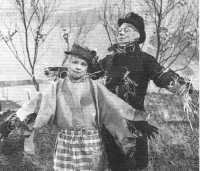 'Worzel Gummidge
turns Detective' (1953)
- was a four part, half-hour comedy series written for TV by
Worzel-creator Barbara Euphan Todd and starred Frank Atkinson as
the animated scarecrow Worzel, pictured with Mabel Constanduros
as Earthy Mangold, and also starred Margaret Boyd as Mrs.
Braithwaite and Philip Roy as Mr. Braithwaite.
'Worzel Gummidge
turns Detective' (1953)
- was a four part, half-hour comedy series written for TV by
Worzel-creator Barbara Euphan Todd and starred Frank Atkinson as
the animated scarecrow Worzel, pictured with Mabel Constanduros
as Earthy Mangold, and also starred Margaret Boyd as Mrs.
Braithwaite and Philip Roy as Mr. Braithwaite.
'Toad of Toad Hall' was presented as a serial in January 1950 starring Kenneth More as Mr. Badger, James Hayter as Mr. Toad with Sam Kydd, Patrick Troughton and Harry Secombe.
'Potts in Parovia' concerned the adventures of ex-Flight Lieutenant Potts. This particular series was shown in 1956 and was followed by other Potts series, including Potts and the Phantom Piper and Potts, Gangbuster.
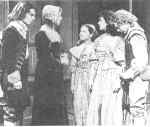 'The Children of the New Forest' - Captain Frederick Marryat's 1847
children's classic, a tale set during the English Civil War, was
originally screened in 1955 and starred Warren Mitchell (as
Cromwell), Colin Douglas, Robert Hewitt, Jon Rollason, John
Charlesworth, Shirley Cooklin, Anthony Valentine, Gillian Gale
and Barbara Hicks.
'The Children of the New Forest' - Captain Frederick Marryat's 1847
children's classic, a tale set during the English Civil War, was
originally screened in 1955 and starred Warren Mitchell (as
Cromwell), Colin Douglas, Robert Hewitt, Jon Rollason, John
Charlesworth, Shirley Cooklin, Anthony Valentine, Gillian Gale
and Barbara Hicks.
'Under the Sea' with Jacques Cousteau (1950).
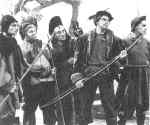 'The Black Arrow' - Robert L. Stevenson's 1888
medieval melodrama concerning action and adventure during the
Wars of the Roses was presented as a two part (40 mins each)
serial in 1951. The cast included (l. to r.) Dennis Clinton, John
Garley, Powys Thomas, Keith Michell and Derek Godfrey; Denis
Quilley (as Richard Shelton) and Tarn Bassett (as Joanna Sedley)
also appeared. Original music by Henry Boyes.
'The Black Arrow' - Robert L. Stevenson's 1888
medieval melodrama concerning action and adventure during the
Wars of the Roses was presented as a two part (40 mins each)
serial in 1951. The cast included (l. to r.) Dennis Clinton, John
Garley, Powys Thomas, Keith Michell and Derek Godfrey; Denis
Quilley (as Richard Shelton) and Tarn Bassett (as Joanna Sedley)
also appeared. Original music by Henry Boyes.
 |
'The Adventures of Sherlock Holmes' (1954-55) starred Ronald Howard as Sherlock Holmes, H. Marion Crawford as Dr. John Watson and Archie Duncan as Inspector Lestrade. |  Theme |
'Can Do - No Can Do' - presented by MacDonald Hobley. Contestants were challenged to forecast whether a particular feat could be done in the time allotted. One was for Reg Harris (British cycling champion of the day) to cycle on his bike, balanced on test rollers, a fixed distance in three minutes. The challenge was always Can Do - No Can Do.
'Potts in Parovia' starred Humphrey Lestocq in his last television role. The second series was set in Scotland and the third in the East End of London.
'The Adventures of Tugboat Annie' - A half-hour situation comedy series, produced by Normandie Productions, in association with Associated Rediffusion. It was shot in Ontario, although the story took place in the U.S. Pacific Northwest. It featured Minerva Urecal as 'Tugboat' Annie Brennan, an "uncouth, earthy, and brawling" widow and captain of a tugboat who piloted her sturdy tug, the Narcissus, through heavy seas and many battles with her long time rival, Capt. Horatio Bullwinkle (Walter Sande), master of the Salamander, with his crewman Jake (James Barron). She is aided by her cook Pinto (Don Orlando) and Whitey( Don Baker) her deckhand.
If you have any comments or further information of interest, please e-mail webmaster@whirligig-tv.co.uk